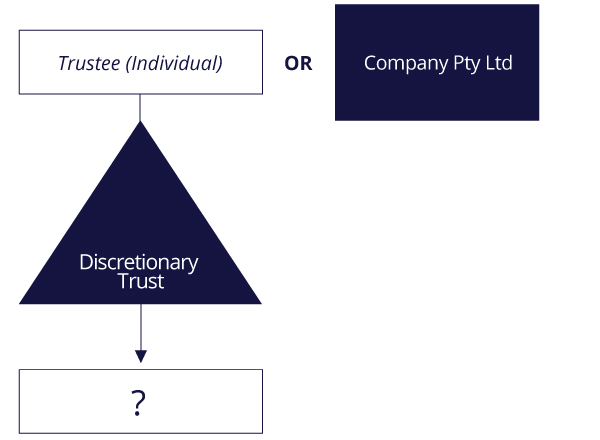Discretionary/Family Trust Structure Guide
There are more than 40 different types of trusts all with different operation and characteristics. One of the more commonly known trusts is a discretionary or family trust. The entity structure hold assets for the benefit of the beneficiaries who are limited to the specific individuals (primary beneficiaries) and their family (secondary beneficiaries).
Structuring Options
A trust may be established with either individual or corporate (company) trustee/s as shown below. In a trust structure the trustee is ultimately responsible for the actions of the trust so this decision is critical where the operations/assets of the trust carry significant risk.
Trustee – The trustee is the controller of the trust and is responsible for day to day operation of the trust. All assets are held by the trustee on behalf of the trust.
Beneficiaries – The beneficiaries are eligible to the distributions of income of the trust and are defined in the trust deed. With a discretionary/family trust, this is determined on an annual basis and any beneficiary who receives a distribution becomes presently entitled to the income with tax being assessed at the beneficiaries respective tax rate.

Trustee – The trustee is the controller of the trust and is responsible for day to day operation of the trust. All assets are held by the trustee on behalf of the trust.
Beneficiaries – The beneficiaries are eligible to the distributions of income of the trust and are defined in the trust deed. With a discretionary/family trust, this is determined on an annual basis and any beneficiary who receives a distribution becomes presently entitled to the income with tax being assessed at the beneficiaries respective tax rate.

Pros
• Ability to income split between multiple individuals each year
• Lower administration/management costs
• Where a business is operated through a trust, the income (if received by individuals) may qualify them for the small business tax offset, providing a reduced tax payable up to $1,000 per person.
• Can provide a cost-effective succession plan for family businesses
• No ownership may increase asset protection for the Trust assets, where there may be personal risk with a particular individual
Cons
• Requirement to distribute income of the trust each year which can create undesirable tax outcomes
• No ability to add a fixed entitlement to capital or income for other parties
• No ownership, which means it’s not an appropriate structure to bring on a business partner
We recommend getting in touch with our team to ensure you have the correct structure setup for you and your business.
Do you think a Company Structure might suit you better? Check out our Private Company Structure Guide here.
For expert advice on trust structures and financial matters in Sunshine Coast, consult with our experienced accountants Sunshine Coast
The information provided on this page is intended to be a general guide only and does not constitute advice. It has not considered your personal circumstances, your particular objectives, financial situation or needs, we recommend seeking independent advice from the respective profession in regards to any information provided on this page.
‘Liability limited by a scheme approved under Professional Standards Legislation’
Structuring Options
A trust may be established with either individual or corporate (company) trustee/s as shown below. In a trust structure the trustee is ultimately responsible for the actions of the trust so this decision is critical where the operations/assets of the trust carry significant risk.

Trustee – The trustee is the controller of the trust and is responsible for day to day operation of the trust. All assets are held by the trustee on behalf of the trust.
Beneficiaries – The beneficiaries are eligible to the distributions of income of the trust and are defined in the trust deed. With a discretionary/family trust, this is determined on an annual basis and any beneficiary who receives a distribution becomes presently entitled to the income with tax being assessed at the beneficiaries respective tax rate.
Pros
• Ability to income split between multiple individuals each year
• Lower administration/management costs
• Where a business is operated through a trust, the income (if received by individuals) may qualify them for the small business tax offset, providing a reduced tax payable up to $1,000 per person.
• Can provide a cost-effective succession plan for family businesses
• No ownership may increase asset protection for the Trust assets, where there may be personal risk with a particular individual
Cons
• Requirement to distribute income of the trust each year which can create undesirable tax outcomes
• No ability to add a fixed entitlement to capital or income for other parties
• No ownership, which means it not an appropriate structure to bring on a business partner
We recommend getting in touch with our team to ensure you have the correct structure setup for you and your business.
Do you think a Company Structure might suit you better? Check out our Private Company Structure Guide here.
The information provided on this page is intended to be a general guide only and does not constitute advice. It has not considered your personal circumstances, your particular objectives, financial situation or needs, we recommend seeking independent advice from the respective profession in regards to any information provided on this page.
‘Liability limited by a scheme approved under Professional Standards Legislation’
Support. Experience. Trust.
CPA Firm
14+ Years Experience
Friendly Team
Contact Us
The team from Avoda Business Advisory would love to hear from you. Please fill out the form below and we will respond to your query within 1 business day.
Alternatively, please call our office on (07) 5451 8751 or use the chat service located at the bottom right of your screen.
